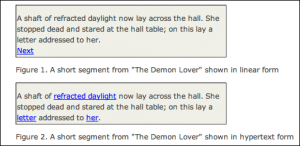Scott Rosenberg (who I was led to by Crawford Killian) shares my skepticism re the “studies” cited by Nick Carr. And what is more, he actually took the trouble to read them carefully and point out some of the nonsense in detail.
Just as I surmised, the studies involve placing deliberately confusing and illogical links in a sequential document and then observing the obvious.

Read the paragraph then link to the next and (surprise!) if the link is not at the bottom of the page it is harder to find it. Not only that, but there is no back button (!) so if the reader wants to explore the link from “refracted daylight” he or she will be taken directly to the next page and miss all of the rest of the current paragraph. And then the researchers (and Carr) have the gall to claim as a significant observation that the hypertext readers “had difficulty following the text”.
At least Carr does have the courage to respond, but his first comment is just useless bafflegab and in his second he asserts (without any reference) that “Scans of the brains of adept readers reveal that the decision-making portions of the prefrontal cortex are calm, allowing the reader to engage deeply in the process of interpreting meaning (which involves different areas of the brain). Making decisions about links, even when we’re not conscious of those decisions, requires the activation of the prefrontal cortex, which breaks the focus required for deep interpretation.” This would actually be interesting IF the “adept readers” were dealing with intellectually demanding content rather than trying to relax with a novel (which is actually the context of the reading in the study excerpt). In the latter case I can imagine having a quiet pfc and not wanting to be bothered with deciding about links. But when reading Carr’s linkless comment I am pretty sure my pfc was flashing just as fast as my blood pressure was rising.
This last bit brings me back to a point at the start of his post on which I do disagree with Rosenberg . Namely the distinction between artistic and informative linking. Academic writing is often not intended to be read quickly, and although the pattern of a single stem with brief footnote leaf excursions is common, there are also many instances of heavily crosslinked educational material – eg Wikipedia, Mathworld, and RealClimate all come to mind as examples. And on the artistic side, to say that multi-path novels were a dead end is ridiculous. In print they were of course a rather silly idea, but what started with Zork! is now a substantial fraction of the entire entertainment and publishing industry. One may argue that these are no longer text, but I believe that is only partly true and also that it will probably will soon become irrelevant.
